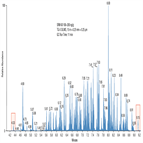Find methods for your needs
Refine by Feature
Displaying 1-5 of 5 results for Tag: GCMS/MS
CAN122: Determination of Persistent Organic Pollutants in Fish Tissues by Accelerated Solvent Extraction and GC-MS/MS
Instrument Type: GCMSMSPolychlorinated biphenyls (PCBs), organochlorine pesticides (OCPs) and polybrominated diphenyl ethers (PBDEs) belong to a broad family of synthetic organic compounds known as halogenated hydrocarbons. Polychlorinated biphenyls (PCBs), organochlorine pesticides (OCPs) and polybrominated diphenyl ethers (PBDEs) belong to a broad family of synthetic organic compounds known as halogenated hydrocarbons. The method reported here is applicable for the determination of 29 halogenated hydrocarbons (6 PCBs, 16 OCPs, and 7 PBDEs) in fish tissues.
Determining Nitrosamines Using GC-MS/MS with Electron Ionization
Instrument Type: GCMSMSThe highly sensitive TSQ Duo triple quadrupole mass spectrometer can analyze nitrosamines in EI mode. Using automatic selected reaction monitoring (AutoSRM) software to fully optimize the choice of transitions and collision energies, equivalent detection limits by EPA method can be achieved without using a large volume injection.
Meeting the Upcoming European Commission Performance Criteria for the Use of Triple Quadrupole GC-MS/MS as a Confirmatory Method for PCDD/Fs in Food and Feed Samples
Instrument Type: GCMSMSPolychlorinated dibenzo-p-dioxins (PCDDs) and polychlorinated dibenzofurans (PCDFs) constitute a group of highly toxic organic compounds. PCDD/Fs have been characterized by the US Environmental Protection Agency as likely to be carcinogenic to humans. Recent technological advances in GC-MS/MS technology led to GC-MS/MS being considered a reliable tool that can be used to control the maximum levels for PCDD/Fs in food and feed. In this work, the performance of the Thermo Scientific TSQ 8000 Evo triple quadrupole GC-MS/MS for the analysis of PCDD/Fs was assessed.
Increasing Productivity in FAMEs Analysis through Increased Selectivity
Instrument Type: GCMSMSIn this work, the performance of the Thermo Scientific TSQ Duo system is assessed for the quantitative analysis of 11 FAMEs in human blood spot extracts. The TSQ Duo system offers analysts a unique choice by allowing the use of single quadrupole methods and enabling the automatic transition to triple quadrupole on the same system. This application note illustrates the stepwise process of upgrading methods from single quadrupole to triple quadrupole using Chromeleon CDS software.
Three-Fold Increase in Productivity for Pesticide Residue Analysis in Baby Food Using Fast Triple Quadrupole GC-MS/MS
Instrument Type: GCMSMSIn this study, a fast, easy, and robust workflow was used to analyze pesticide residues in baby food. Accurate and sensitive detection, quantification, and identification of pesticides in baby foods is of particular importance because babies are more vulnerable to adverse health effects from these chemicals.





